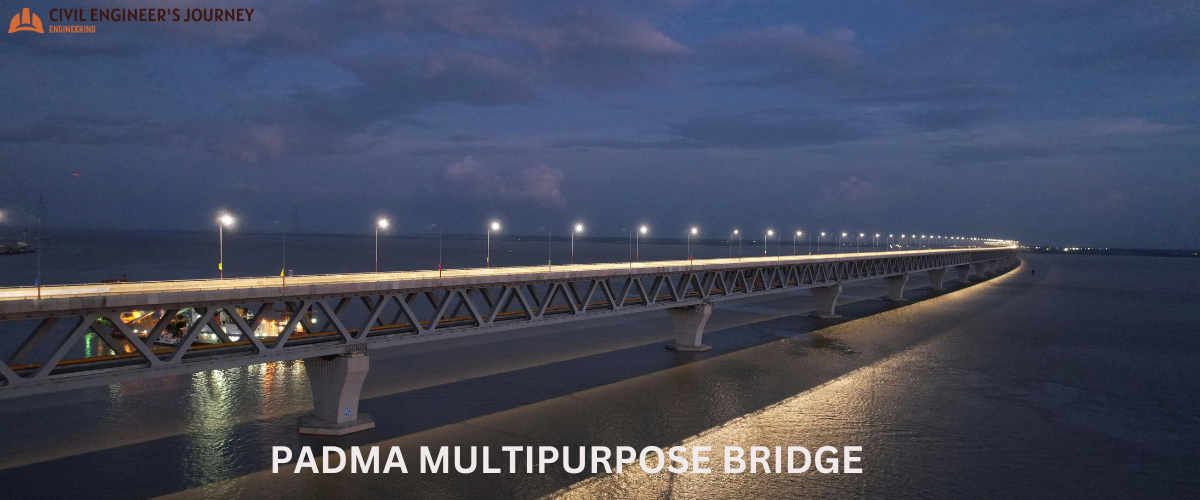
Padma Multipurpose Bridge is a two-level road-rail bridge across the Padma River in Bangladesh.This girder bridge connects the northeastern states of Assam and Arunachal Pradesh in India.Prime Minister Sheikh Hasina inaugurated the Padma Bridge at morning on 25 June 2022.One of the largest bridges in South Asia, the bridge will make traveling to Dhaka easier and less time-consuming for people from the south-southwest regions of the country. As a result of this bridge, the journey from Shariatpur, Madaripur, Gopalganj, Faridpur, and Narail to Dhaka will take 60 to 70 minutesThat’s why millions of people, including many businessmen and ordinary people, are preparing for a new dream.The Padma Bridge sees an average of 75,000 vehicles running on it each day. The bridge is designed a two-level road-rail bridge access with an under-rail section while the top part is reserved for vehicles to pass through.
Bangladesh’s Padma Bridge is an iconic symbol of national development and engineering. The careful planning and innovative design of this monumental structure played a key role in shaping its functionality, beauty, and long-term sustainability. Take a look at the intricate details of the planning and design process that helped make the Padma Bridge a wonder of modern engineering.
The construction of the Padma Multipurpose Bridge started on November 26, 2014, and ended on March 23, 2022. The Ministry of Road Transport and Bridges, Bridges Division, Bangladesh Bridge Authority constructed it
The Padma Multipurpose Bridge project’s total cost is Tk32,605 crore. Which was funded by the Bangladesh government, with the government providing a grant of Tk300 crore and the remaining Tk29,893 crore as a loan with a 1% annual interest rate. The Padma Bridge in Bangladesh has a four-lane carriageway for road transportation on the top deck and also a single railway track on the bottom deck. The Padma Bridge spans the fast-flowing Padma River, the second largest river in the world by water flow after the Amazon River.
The bridge’s physical work is divided into five packages: (i) Main Road, (ii) Rail Bridge, (iii) River regimen, (iv) Jazira Approach Road, (v) Toll Plaza, and Mawa and Jajira Service Area. One of the most difficult aspects of the Padma Bridge’s construction is the river routine.
Special notes for Toll Plaza: People in the country’s southwest will find it easier and take longer to travel with Dhaka thanks to the bridge, which is among the biggest in South Asia. This bridge facilitates the daily use of numerous vehicles. Toll systems need to be updated in this regard and caused multiple traffic jams in Bangladesh on any given occasion. The Padma Bridge toll plaza needs to be digitalized.




The final construction of the Padma Bridge in Bangladesh marks a historic moment in the country’s infrastructure development. Once construction is complete, the bridge will undergo a series of comprehensive implementation stages to ensure operational readiness, socio-economic impact, and long-term sustainability.
Operational Readiness
The final implementation of the Padma Bridge will include a rigorous testing, inspection, and certification process to verify its structural integrity, load-bearing capacity, and compliance with safety standards. Precisely designed mechanisms for bridge operations, such as traffic management, toll collection, and emergency protocols, are carefully calibrated to ensure smooth functioning. Additionally, the integration of cutting-edge technology facilitates real-time monitoring of bridge health, traffic flow, and weather conditions, improving operational efficiency and safety.
Socio-economic impact
The realization of the Padma Bridge goes far beyond its physical structure as it becomes a catalyst for socio-economic transformation. The increased connectivity provided by bridges has opened up new opportunities for trade, commerce, tourism, and cultural exchange. It serves as a central link that connects communities, stimulates local development, and strengthens local economies. The job creation, skills development and entrepreneurial prospects brought about by bridge construction attest to their far-reaching socio-economic impact.
Integrated Development Initiatives
The final stage of implementation of Padma Bridge will be accompanied by a comprehensive framework of integrated development initiatives. These include the construction of transit-oriented infrastructure such as terminals, service facilities, and support systems to optimize the bridge’s usability and accessibility. In addition, education, health care, and community development programs will be strategically deployed to leverage the bridge’s connectivity to advance the entire region.
Parallel to the implementation of its operations, Padma Bridge maintains its commitment to environmental protection. Green infrastructure practices, green maintenance protocols and ecosystem protection efforts are at the forefront, demonstrating a proactive approach to minimizing the bridge’s environmental footprint and protecting the natural environment. Bridge construction must be in harmony with the ecosystem and promote a sustainable balance between development and environmental protection.
The long-held dream of Padma Bridge will finally come true. 25th. Significant events await in June 2022. Prime Minister Sheikh Hasina inaugurates this huge infrastructure project. The list of invitees includes ambassadors from various countries in Dhaka, heads of international organizations, and the president of the World Bank.
In conclusion, Padma Bridge is a monumental achievement for Bangladesh and heralds a new era of connectivity, economic growth and development for the country. This iconic infrastructure project promises to reduce travel times, boost regional trade and improve the country’s overall socio-economic situation. The Padma Bridge, the largest bridge in Bangladesh, serves as a symbol of national pride, innovation and technological excellence. Its role in improving transport efficiency and connectivity across the Padma River highlights its importance in promoting economic progress and social welfare.
Moreover, the completion and opening of the Padma Bridge represents an important milestone in Bangladesh’s infrastructure development quest, positioning the country as a regional power and strengthening its global position. In particular, the bridge opening ceremony will bring together dignitaries, officials and representatives from various sectors, demonstrating the joint efforts and common vision behind this transformative undertaking.